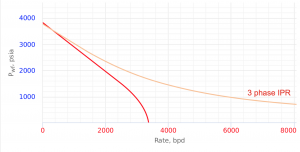Difference between revisions of "3 Phase IPR"
From wiki.pengtools.com
(→Three-phase Inflow Performance Relationship) |
(→References) |
||
| Line 48: | Line 48: | ||
=== References === | === References === | ||
<references> | <references> | ||
| − | <ref name= | + | <ref name= KermitBrown1984 >{{cite book |
| − | |last1= | + | |last1= Brown |first1= Kermit |
| − | |title= | + | |title=The Technology of Artificial Lift Methods. Volume 4. Production Optimization of Oil and Gas Wells by Nodal System Analysis |
| − | | | + | |publisher=PennWellBookss |
| − | | | + | |date=1984 |
| − | | | + | |place=Tulsa, Oklahoma |
| − | |||
}}</ref> | }}</ref> | ||
Revision as of 08:02, 11 April 2019
Contents
Three-phase Inflow Performance Relationship

3 Phase IPR Curve [1]
3 Phase IPR calculates IPR curve for oil wells producing water.
3 Phase IPR equation was derived by Petrobras based on combination of Vogel's IPR equation for oil flow and constant productivity for water flow [1].
3 Phase IPR curve is determined geometrically from those equations considering the fractional flow of oil and water [1].
Math and Physics
Oil well IPR equation
- Darcy's law equation for the single-phase flow of incompressible liquid:
- Vogel's IPR two-phase flow equation (oil + gas) and it's combination with single phase liquid
- 3 Phase IPR three-phase flow equation (oil + gas + water)
Gas well IPR equation
- Darcy's law gas inflow equation:
- C and n equation
IPR calculator software
- PQplot nodal analysis software is used to calculate the IPR curves. PQplot is available online at www.pengtools.com.
- Excel
- other
Nomenclature
 = formation volume factor, bbl/stb
= formation volume factor, bbl/stb = dimensionless productivity index, dimensionless
= dimensionless productivity index, dimensionless = permeability times thickness, md*ft
= permeability times thickness, md*ft = average reservoir pressure, psia
= average reservoir pressure, psia = average reservoir pseudopressure, psia2/cP
= average reservoir pseudopressure, psia2/cP = well flowing pressure, psia
= well flowing pressure, psia = average well flowing pseudopressure, psia2/cP
= average well flowing pseudopressure, psia2/cP = flowing rate, stb/d
= flowing rate, stb/d = gas rate, MMscfd
= gas rate, MMscfd = temperature, °R
= temperature, °R
Greek symbols
 = viscosity, cp
= viscosity, cp


